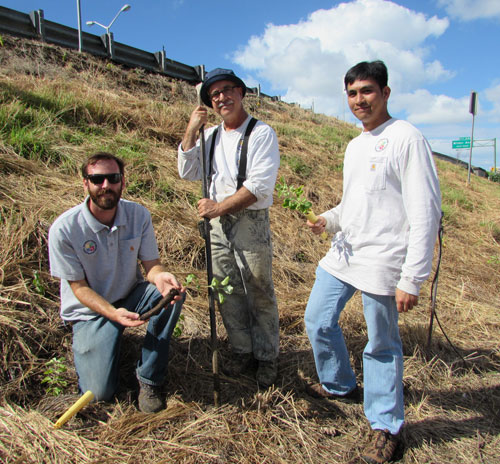Creating a roadside nursery for native plants

If University of Hawai‘i weed specialist Joseph DeFrank had his way, Hawai‘i highway right-of-ways would not only be showcases for native landscaping, they’d be seed production plots as well. The state Department of Transportation is investing in his vision with a three-year $190,000 grant to explore cover grasses and another three-year $249,000 grant to evaluate broadleaf plants.
Working on a demonstration site inside the University Street onramp to westbound H1, DeFrank and his College of Tropical Agriculture and Human Resources graduate students are establishing the protocols for preparing sites, readying planting materials, establishing plants, and producing seeds. The work will expand to the larger Halawa interchange this year.
Plants, selected from eligible candidates identified by the USDA National Resources Conservation Service’s Plant Materials Center on Moloka‘i, include four native grass groundcovers (piligrass, emoloa, kamanomano, and konakona) and five shubs (a‘ali‘i, ahinahina, aweoweo, ilima, and uhaloa).
DeFrank plans to simulate a dryland ecosystem on steeper banks and harvest seed on flat areas. The potential benefits are manyfold, he says. Beyond controlling erosion, the use of native plantings
- provides a habitat for beneficial insects, including pollinators, and source of food for birds that can disperse the native seeds.
- displaces invasive species along roadways (a proven corridor for spreading to new areas).
- creates a reservoir of native seeds for various uses.
- provides opportunities for Adopt-a-Highway groups to learn about native species and help harvest seeds.
- reduces maintenance costs once established, and possibly generate revenue through seed production as a business venture.
- mitigates the heating and drying effect of hard urban landscapes.
O‘o in hand, DeFrank pauses to wipe his brow during a workday at the University onramp site. “This is a mini lab,” he says with satisfaction. “Before, it was just another maintenance expense for the state.”
He shares the plot with Chittaranjan Ray, of the UH Water Resources Research Center, who is examining soil remediation. He also collaborates with Nellie Sugii, from the university’s Lyon Arboretum, who is working to identify and test native ferns suitable for the cooler, wetter conditions of higher elevation roadways.
—From CTAHR in Focus, January 2014